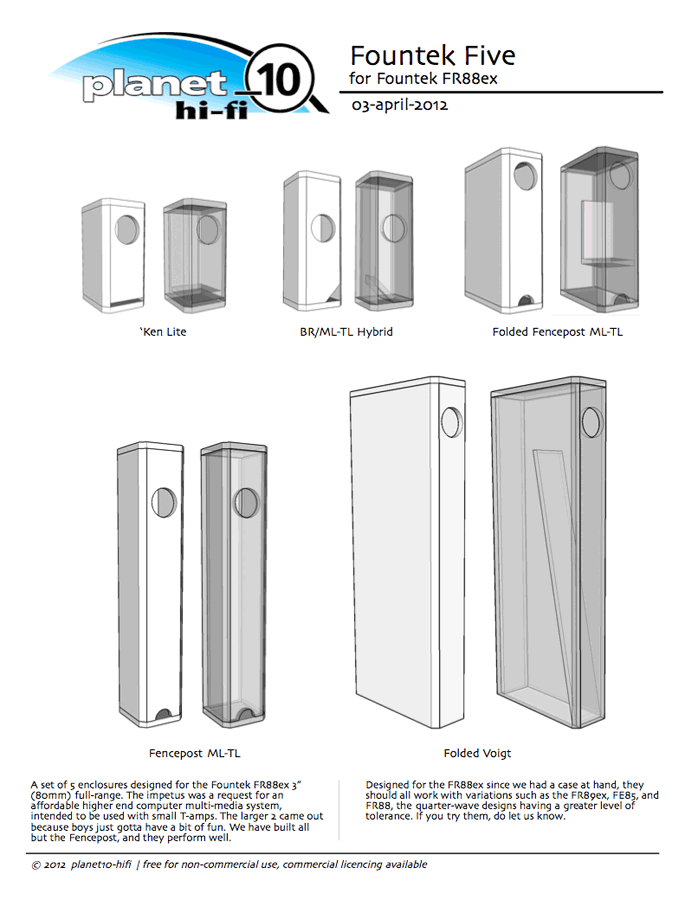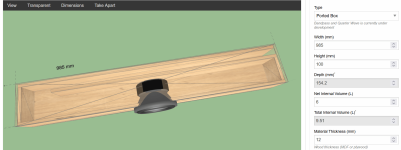When setting loudspeaker cab and port proportions, does anyone know at what point does the bass reflex driver volume and port becomes a 2 segment TL?
This is the box that is buggering things up, Should I rely on Winisd for a bass reflex or HR for TL? Is this a BR or TL?


This is the box that is buggering things up, Should I rely on Winisd for a bass reflex or HR for TL? Is this a BR or TL?
Attachments
I'll have to look up what box modes are. Sorry man, I am new to this side of building a speakerThe point is where box modes become part of the design.
The transmission line effects include the sound reflecting back and forth through the line. This resonance affects the bass, and the frequencies are related to the line lengths. These are the modes.
Compare to a reflex box, the box dimensions should be small enough that these modes are too high in frequency to be having an effect on the bass, and they are mostly removed by stuffing.
The stuffing in a transmission line isn't meant to remove those low bass modes, but to adjust their level.
Compare to a reflex box, the box dimensions should be small enough that these modes are too high in frequency to be having an effect on the bass, and they are mostly removed by stuffing.
The stuffing in a transmission line isn't meant to remove those low bass modes, but to adjust their level.
Can't really find anything with a google search for speaker box modes. Does it have to do with the resulting music sounding effected at a point? That is building for effected sound, similar to picking valves over solid state? I don't know if I am getting what it means for the sound, and I hope it doesn't mean that pushing a BR to TL proportions would result in an effected sound
No, it's fine in the bass if it's balanced. It can get troublesome if you don't damp the highs.
A mode is only where the sound travels a particular way around the box and adds up at certain frequencies. It gives you a boost at some frequencies.
A mode is only where the sound travels a particular way around the box and adds up at certain frequencies. It gives you a boost at some frequencies.
I always get the feeling that I am not entering all the data properly, so I usually avoid the sound modelling and build to the recommended volumes. Trying to learn the limits of manipulating the dimensions for a given volume for BR and also to use Winisd and HR properly. I need to use BR due to space constraints but it ends up looking like a TL. The box in the posted pic, is this best modelled in Winisd or HR?
Let's assume it's meant to be a bass reflex for a moment..
The box is 1m long with the driver in the middle, so your lowest (first) cancellation mode will be at around 170Hz.
Then the port, since it's around 90cm long, will have a pipe resonance at around 95Hz. This is in a place where it can interfere although I'm not going to guess at the result.
Whether it behaves as one or the other can be a grey area. I'd rather use hornresp or a simulator that can handle these resonances properly in this case.
The box is 1m long with the driver in the middle, so your lowest (first) cancellation mode will be at around 170Hz.
Then the port, since it's around 90cm long, will have a pipe resonance at around 95Hz. This is in a place where it can interfere although I'm not going to guess at the result.
Whether it behaves as one or the other can be a grey area. I'd rather use hornresp or a simulator that can handle these resonances properly in this case.
Thanks for the education Allen. I am trying to understand, but I am stumbling over unfamiliar terminology
When you say pipe resonance, you don't mean the pipe vibrating when it encounters 95hz sound, do you?pipe resonance at around 95Hz.
Yes, but it's the air within the pipe reacting to it's length.
However I'd instead model it as a 3 section horn (or offset horn, I haven't done one in a while and would ask on the hornresp thread), since this clearly lays out the driver in the middle of the box and should be the more informative simulation.
I should add that hornresp can model this two ways. It can do a simple reflex box with the box length and port length added to include the modes.the feeling that I am not entering all the data properly,
However I'd instead model it as a 3 section horn (or offset horn, I haven't done one in a while and would ask on the hornresp thread), since this clearly lays out the driver in the middle of the box and should be the more informative simulation.
Why put the driver midway between the box if it is a bass reflex? It looks like you could also ask if it is a stubbed horn versus a TL or BR. Does it need to be there and the port to the right?
Typically you would want to put the driver more to the 'top' (right in your picture) for a BR or a TL because you want to use the pathlength of the chamber (the length of the rear of the driver to the port exit) to your advantage. The positioning you have will encourage standing wave cancellation, as I think AllenB is pointing out, around 170 kHz. And I haven't done the math but I am assuming that there are troublesome subharmonics that could be problematic as well.
Typically you would want to put the driver more to the 'top' (right in your picture) for a BR or a TL because you want to use the pathlength of the chamber (the length of the rear of the driver to the port exit) to your advantage. The positioning you have will encourage standing wave cancellation, as I think AllenB is pointing out, around 170 kHz. And I haven't done the math but I am assuming that there are troublesome subharmonics that could be problematic as well.
Thank you taking the time to go through all that. Just checking to see that I am on the right tack, my sections would be 50cm and 50cm and 90cm? And choose offset driver? I can't find anywhere in Hornresp to start a horn, is this same as TL? If so, I have been going nuts with that and I can take those resulting pipes and make them dance in CAD but the graphs in HR are so different from Winisd and I don't know if I am onto a good thing or not
Thanks for taking the time, man. I am making a 2.1 soundbar and trying to locate the sub in the centre of it. I don't like having the port to the side like that as some bass notes sound weird, so a few days ago I tried to redraw it as a tapered pipe and bent it around so that everything is on the right place on the face in a test drawing and posted it in another thread as something that I would like to make and test as I have absolutely no idea how it would sound. It's just a pipe tapered from 90 square cm to 20 and folded until the drivers are in place on the front. But I think it was a distraction from that project, and I am just coming back to some time to work on this soundbar as the drivers are on their wayWhy put the driver midway between the box if it is a bass reflex? It looks like you could also ask if it is a stubbed horn versus a TL or BR. Does it need to be there and the port to the right?
To be honest, I really don't want the space penalty of TL, in Winisd the driver models well in that tiny BR. I thought I was onto a good thing and now lost again 😀
A BR will transition into a TL as the aspect ratio becones more severe.
Given the large number og degrees of freedom in the design of a TL it gets too complicated to do anythign but look at what the models say. The quarter-wave effects ill start to show up as the transition is happening as you mutate the box.
dave
Given the large number og degrees of freedom in the design of a TL it gets too complicated to do anythign but look at what the models say. The quarter-wave effects ill start to show up as the transition is happening as you mutate the box.
dave
Thanks Dave
I am able to enter data and get resulting graphs in Hornresp, but I need to see some examples of what a good frequency response looks like. What I am getting seems to be all over the place. Is this a bad result between 30-70hz?

I am able to enter data and get resulting graphs in Hornresp, but I need to see some examples of what a good frequency response looks like. What I am getting seems to be all over the place. Is this a bad result between 30-70hz?
It looks like a pretty severe port for a bass reflex and I would double-check the velocity of air to see if you are going to get chuffing at the port at high excursion. Your last drawing shows a port at the front, perhaps you could consider a symmetric port on either side near the speaker to keep the symmetry? Like the drawing below...If you need room for the other drivers you could just move the ports back...just like you have on the right side of your drawing, only shorter.

Last edited by a moderator:
Randy, you need to add some dampingm to really see but… doesn’t look great — attempt to get to low — to someone who mostly ignirs the undamped graphs.
List all the peaks — frequency and magnitude -- each represents a resonance. The spacing I believe in a reflex you will not see them. The relationship between the numbers tells a story.
We need an expert. @Scottmoose
As an example, this planset is essentially an exploration, with a reflex, a hybrid, an ML-TL (folded & unfolded), and a Voigt.

http://p10hifi.net/FAL/downloads/Fountek-Five-planset-030412.pdf
https://www.diyaudio.com/community/threads/the-fountek-five-for-fr88ex.210106/
dave
List all the peaks — frequency and magnitude -- each represents a resonance. The spacing I believe in a reflex you will not see them. The relationship between the numbers tells a story.
We need an expert. @Scottmoose
As an example, this planset is essentially an exploration, with a reflex, a hybrid, an ML-TL (folded & unfolded), and a Voigt.

http://p10hifi.net/FAL/downloads/Fountek-Five-planset-030412.pdf
https://www.diyaudio.com/community/threads/the-fountek-five-for-fr88ex.210106/
dave
- Home
- Loudspeakers
- Subwoofers
- Is it a bass reflex or TL?
